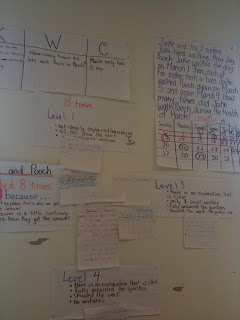 Adrienne's Grade 2/3 class is starting to work towards self assessment. We were co-teaching a lesson together in a three part lesson format (M.A.T.C.H.) and things took a different turn when we were about to consolidate:
Adrienne's Grade 2/3 class is starting to work towards self assessment. We were co-teaching a lesson together in a three part lesson format (M.A.T.C.H.) and things took a different turn when we were about to consolidate:Here is how the lesson went -
Minds on - We had the students discuss things they don't do everyday, but perhaps every other day.
Action - The problem we decided to do was about Jake and his sisters and how many times in a month Jake walked the family dog. Before we sent them on their way to solve the problem, we had them complete a KWC chart to help clarify their knowledge. They wrote the items in the "K" column, but for the sake of Time, we scribed their answers for the other two columns.
Consolidation - As we were about to start the consolidation piece. Adrienne brought forth the idea of turning their work into an anchor chart to help the students assess themselves on their own work. This is what her school is focusing on for their pathway for this term (Note: the pathway is rooted in Literacy, but Adrienne wanted to try it out in Math as well).
We brought the students back to the carpet and asked someone to share the answer with us. The answer was written down verbatim. It was "He walked 8 times." We asked the students what kind of answer this was and why. At first, the students thought that it was a Level 1 answer. But then quickly decided that it was not a Level 1, but a Level 2 answer. (The bright pink paper is because of this change). They then provided justification for their levelling: It doesn't explain how or why we got the answer; the answer is a little confusing; not sure how they got the answer. We then began to work ahead and had someone share why they thought that their work was a Level 3. Once again, they went through the same criteria and came up with justification: there is an explanation that is clear; only 1 small mistake; fully answered the question; showed the work - the pattern rule.
At this point we had to stop for recess and then prep. However, later in the day Adrienne went back to the carpet with the students and had them do the same for Level 1 and Level 4 work. Once all of the Levels and justifications were up, students then got the chance to Level themselves according to the criteria that they had come up with. But - They didn't stop here.
The students then went back and, (using a coloured pencil crayon) made additions to their work to help the quality of their work improve. This was called the "editing process."
For Home, the students were then asked to complete a journal question relating to the work that was done in class today.
The picture shows the work displayed on her wall. How it is set up shows both the problem and the graphic organizer (In this case the KWC chart) and it also has the samples of the student work (with the names cut off) of where it would have fallen BEFORE "editing." If you notice, there are a lot of samples in between Level 2 and Level 3 - This is because those students are at a Level 2+ (based on their original work).
This activity was very powerful for both Adrienne and her students. She now will plan further lessons with those Level 2 students in mind and have a visual reference to help guide her in her planning.
Including the inital part of the lesson, she spent about 50 minutes in total on this lesson - Not a great amount of time, but a powerful use of time. Which goes to show, that a three part lesson can be accomplished in one day.